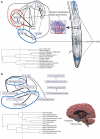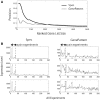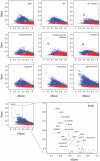Measuring cell identity in noisy biological systems
- PMID: 21803789
- PMCID: PMC3241637
- DOI: 10.1093/nar/gkr591
Measuring cell identity in noisy biological systems
Abstract
Global gene expression measurements are increasingly obtained as a function of cell type, spatial position within a tissue and other biologically meaningful coordinates. Such data should enable quantitative analysis of the cell-type specificity of gene expression, but such analyses can often be confounded by the presence of noise. We introduce a specificity measure Spec that quantifies the information in a gene's complete expression profile regarding any given cell type, and an uncertainty measure dSpec, which measures the effect of noise on specificity. Using global gene expression data from the mouse brain, plant root and human white blood cells, we show that Spec identifies genes with variable expression levels that are nonetheless highly specific of particular cell types. When samples from different individuals are used, dSpec measures genes' transcriptional plasticity in each cell type. Our approach is broadly applicable to mapped gene expression measurements in stem cell biology, developmental biology, cancer biology and biomarker identification. As an example of such applications, we show that Spec identifies a new class of biomarkers, which exhibit variable expression without compromising specificity. The approach provides a unifying theoretical framework for quantifying specificity in the presence of noise, which is widely applicable across diverse biological systems.
Figures







Similar articles
-
Temporal transcriptional logic of dynamic regulatory networks underlying nitrogen signaling and use in plants.Proc Natl Acad Sci U S A. 2018 Jun 19;115(25):6494-6499. doi: 10.1073/pnas.1721487115. Epub 2018 May 16. Proc Natl Acad Sci U S A. 2018. PMID: 29769331 Free PMC article.
-
Identification of transcription factor's targets using tissue-specific transcriptomic data in Arabidopsis thaliana.BMC Syst Biol. 2010 Sep 13;4 Suppl 2(Suppl 2):S2. doi: 10.1186/1752-0509-4-S2-S2. BMC Syst Biol. 2010. PMID: 20840729 Free PMC article.
-
Interlinked nonlinear subnetworks underlie the formation of robust cellular patterns in Arabidopsis epidermis: a dynamic spatial model.BMC Syst Biol. 2008 Nov 17;2:98. doi: 10.1186/1752-0509-2-98. BMC Syst Biol. 2008. PMID: 19014692 Free PMC article.
-
Manipulating large-scale Arabidopsis microarray expression data: identifying dominant expression patterns and biological process enrichment.Methods Mol Biol. 2009;553:57-77. doi: 10.1007/978-1-60327-563-7_4. Methods Mol Biol. 2009. PMID: 19588101 Free PMC article. Review.
-
Gene regulatory networks in the Arabidopsis root.Curr Opin Plant Biol. 2013 Feb;16(1):50-5. doi: 10.1016/j.pbi.2012.10.007. Epub 2012 Nov 26. Curr Opin Plant Biol. 2013. PMID: 23196272 Review.
Cited by
-
Changes in Gene Expression in Space and Time Orchestrate Environmentally Mediated Shaping of Root Architecture.Plant Cell. 2017 Oct;29(10):2393-2412. doi: 10.1105/tpc.16.00961. Epub 2017 Sep 11. Plant Cell. 2017. PMID: 28893852 Free PMC article.
-
A Conceptual Framework for Cell Identity Transitions in Plants.Plant Cell Physiol. 2018 Apr 1;59(4):691-701. doi: 10.1093/pcp/pcx172. Plant Cell Physiol. 2018. PMID: 29136202 Free PMC article. Review.
-
Spatiotemporal expression patterns of anxiety disorder-associated genes.Transl Psychiatry. 2023 Dec 13;13(1):385. doi: 10.1038/s41398-023-02693-y. Transl Psychiatry. 2023. PMID: 38092764 Free PMC article.
-
The potential of single-cell profiling in plants.Genome Biol. 2016 Apr 5;17:65. doi: 10.1186/s13059-016-0931-2. Genome Biol. 2016. PMID: 27048384 Free PMC article.
-
Peripheral blood cells inform on the presence of breast cancer: a population-based case-control study.Int J Cancer. 2015 Feb 1;136(3):656-67. doi: 10.1002/ijc.29030. Epub 2014 Jun 25. Int J Cancer. 2015. PMID: 24931809 Free PMC article.
References
-
- Gould J, Getz G, Monti S, Reich M, Mesirov JP. Comparative gene marker selection suite. Bioinformatics. 2006;22:1924–1925. - PubMed
-
- Arendt D. The evolution of cell types in animals: emerging principles from molecular studies. Nat. Rev. Genet. 2008;9:868–882. - PubMed
-
- Sugino K, Hempel CM, Miller MN, Hattox AM, Shapiro P, Wu C, Huang ZJ, Nelson SB. Molecular taxonomy of major neuronal classes in the adult mouse forebrain. Nat. Neurosci. 2006;9:99–107. - PubMed
-
- Birnbaum K, Shasha DE, Wang JY, Jung JW, Lambert GM, Galbraith DW, Benfey PN. A gene expression map of the Arabidopsis root. Science. 2003;302:1956–1960. - PubMed
Publication types
MeSH terms
Substances
Grants and funding
LinkOut - more resources
Full Text Sources
Other Literature Sources
Research Materials

